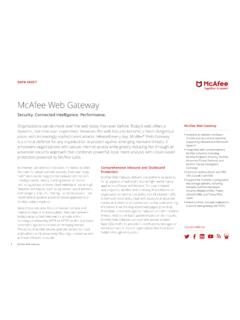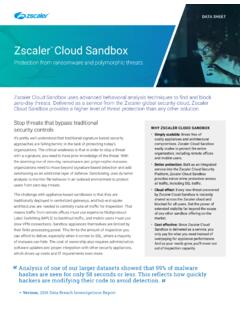Transcription of CompTIA Cybersecurity Analyst (CySA+) Certification Exam ...
1 CompTIA Cybersecurity Analyst (CySA+) Certification Exam ObjectivesEXAM NUMBER: CS0-001 The CompTIA Cybersecurity Analyst (CySA+) Certification is a vendor-neutral credential. The CompTIA CySA+ exam is an internationally targeted validation of intermediate-level security skills and knowledge. While there is no required prerequisite, the CompTIA CySA+ Certification is intended to follow CompTIA Security+ or equivalent experience and has a technical, hands-on focus on IT security CompTIA CySA+ examination is designed for IT security analysts, vulnerability analysts, or threat intelligence analysts. The exam will certify that the successful candidate has the knowledge and skills required to configure and use threat detection tools, perform data analysis and interpret the results to identify vulnerabilities, threats , and risks to an organization with the end goal of securing and protecting applications and systems within an is recommended for CompTIA CySA+ Certification candidates to have the following.
2 3-4 years of hands-on information security or related experience Network+, Security+, or equivalent knowledgeCompTIA AUTHORIZED MATERIALS USE POLICY CompTIA Certifications, LLC is not affiliated with and does not authorize, endorse or condone utilizing any content provided by unauthorized third-party training sites (aka brain dumps ). Individuals who utilize such materials in preparation for any CompTIA examination will have their certifications revoked and be suspended from future testing in accordance with the CompTIA Candidate Agreement. In an effort to more clearly communicate CompTIA s exam policies on use of unauthorized study materials, CompTIA directs all Certification candidates to the CompTIA Certification Exam Policies.
3 Please review all CompTIA policies before beginning the study process for any CompTIA exam. Candidates will be required to abide by the CompTIA Candidate Agreement. If a candidate has a question as to whether study materials are considered unauthorized (aka brain dumps ), he/she should contact CompTIA at to NOTEThe lists of examples provided in bulleted format are not exhaustive lists. Other examples of technologies, processes or tasks pertaining to each objective may also be included on the exam although not listed or covered in this objectives document. CompTIA is constantly reviewing the content of our exams and updating test questions to be sure our exams are current and the security of the questions is protected.
4 When necessary, we will publish updated exams based on existing exam objectives. Please know that all related exam preparation materials will still be valid. yAbout the ExamCompTIA Cybersecurity Analyst (CySA+) Certification Exam Objectives Version DETAILSR equired exam CS0-001 Number of questions Maximum of 85 Types of questions Multiple choice and performance-based Length of test 165 Minutes Recommended experience Network+, Security+, or equivalent knowledge. Minimum of 3-4 years of hands-on information security or related experience. While there is no required prerequisite, CySA+ is intended to follow CompTIA Security+ or equivalent experience and has a technical, hands-on focus. Passing score 750 (on a scale of 100 900) EXAM OBJECTIVES (DOMAINS)The table below lists the domains measured by this examination and the extent to which they are represented.
5 The CompTIA CySA+ exam is based on these objectives. CompTIA Cybersecurity Analyst (CySA+) Certification Exam Objectives Version PERCENTAGE OF Threat Management 27% Vulnerability Management 26% Cyber Incident Response 23% Security Architecture and Tool Sets 24%Total 100% Procedures/common tasks - Topology discovery - OS fingerprinting - Service discovery - Packet capture - Log review - Router/firewall ACLs review - Email harvesting - Social media profiling - Social engineering - DNS harvesting - Phishing Variables - Wireless vs. wired - Virtual vs. physical - Internal vs. external - On-premises vs. cloud Tools - NMAP - Host scanning - Network mapping - NETSTAT - Packet analyzer - IDS/IPS - HIDS/NIDS - Firewall rule-based and logs - Syslog - Vulnerability scanner Point-in-time data analysis - Packet analysis - Protocol analysis - Traffic analysis - Netflow analysis - Wireless analysis Data correlation and analytics - Anomaly analysis - Trend analysis - Availability analysis - Heuristic analysis - Behavioral analysis Data output - Firewall logs - Packet captures - NMAP scan results - Event logs - Syslogs - IDS report Tools - SIEM - Packet analyzer - IDS - Resource monitoring tool - Netflow Threat ManagementGiven a scenario.
6 Apply environmental reconnaissance techniques using appropriate tools and a scenario, analyze the results of a network Cybersecurity Analyst (CySA+) Certification Exam Objectives Version Threat ManagementGiven a network-based threat, implement or recommend the appropriate response and Network segmentation - System isolation - Jump box Honeypot Endpoint security Group policies ACLs - Sinkhole Hardening - Mandatory Access Control (MAC) - Compensating controls - Blocking unused ports/services - Patching Network Access Control (NAC) - Time-based - Rule-based - Role-based - Location-based Penetration testing - Rules of engagement - Timing - Scope - Authorization - Exploitation - Communication - Reporting Reverse engineering - Isolation/sandboxing - Hardware - Source authenticity of hardware - Trusted foundry - OEM documentation - Software/malware - Fingerprinting/hashing - Decomposition Training and exercises - Red team - Blue team - White team Risk evaluation - Technical control review - Operational control review - Technical impact and likelihood
7 - High - Medium - LowExplain the purpose of practices used to secure a corporate Cybersecurity Analyst (CySA+) Certification Exam Objectives Version Vulnerability Management Identification of requirements - Regulatory environments - Corporate policy - Data classification - Asset inventory - Critical - Non-critical Establish scanning frequency - Risk appetite - Regulatory requirements - Technical constraints - Workflow Configure tools to perform scans according to specification - Determine scanning criteria - Sensitivity levels - Vulnerability feed - Scope - Credentialed vs. non-credentialed - Types of data - Server-based vs. agent-based - Tool updates/plug-ins - SCAP - Permissions and access Execute scanning Generate reports - Automated vs.
8 Manual distribution Remediation - Prioritizing - Criticality - Difficulty of implementation - Communication/change control - Sandboxing/testing - Inhibitors to remediation - MOUs - SLAs - Organizational governance - Business process interruption - Degrading functionality Ongoing scanning and continuous monitoring Analyze reports from a vulnerability scan - Review and interpret scan results - Identify false positives - Identify exceptions - Prioritize response actions Validate results and correlate other data points - Compare to best practices or compliance - Reconcile results - Review related logs and/ or other data sources - Determine trends Servers Endpoints Network infrastructure Network appliances Virtual infrastructure - Virtual hosts - Virtual networks - Management interface Mobile devices Interconnected networks Virtual Private Networks (VPNs) Industrial Control Systems (ICSs) SCADA devicesGiven a scenario, implement an information security vulnerability management a scenario, analyze the output resulting from a vulnerability and contrast common vulnerabilities found in the following targets within an Cybersecurity Analyst (CySA+) Certification Exam Objectives Version Cyber Incident Response Threat classification - Known threats vs.
9 Unknown threats - Zero day - Advanced persistent threat Factors contributing to incident severity and prioritization - Scope of impact - Downtime - Recovery time - Data integrity - Economic - System process criticality - Types of data - Personally Identifiable Information (PII) - Personal Health Information (PHI) - Payment card information - Intellectual property - Corporate confidential - Accounting data - Mergers and acquisitions Forensics kit - Digital forensics workstation - Write blockers - Cables - Drive adapters - Wiped removable media - Cameras - Crime tape - Tamper-proof seals - Documentation/forms - Chain of custody form - Incident response plan - Incident form - Call list/escalation list Forensic investigation suite - Imaging utilities - Analysis utilities - Chain of custody - Hashing utilities - OS and process analysis - Mobile device forensics - Password crackers - Cryptography tools - Log viewers Stakeholders - HR - Legal - Marketing - Management Purpose of communication processes.
10 Limit communication to trusted parties - Disclosure based on regulatory/ legislative requirements - Prevent inadvertent release of information - Secure method of communication Role-based responsibilities - Technical - Management - Law enforcement - Retain incident response providerGiven a scenario, distinguish threat data or behavior to determine the impact of an a scenario, prepare a toolkit and use appropriate forensics tools during an the importance of communication during the incident response Cybersecurity Analyst (CySA+) Certification Exam Objectives Version Cyber Incident ResponseGiven a scenario, analyze common symptoms to select the best course of action to support incident Common network-related symptoms - Bandwidth consumption - Beaconing - Irregular peer-to-peer communication - Rogue devices on the network - Scan sweeps - Unusual traffic spikes Common host-related symptoms - Processor consumption - Memory consumption - Drive capacity consumption - Unauthorized software - Malicious processes - Unauthorized changes - Unauthorized privileges - Data exfiltration Common application-related symptoms - Anomalous activity - Introduction of new accounts - Unexpected output - Unexpected outbound communication - Service interruption - Memory overflows Containment techniques - Segmentation.





